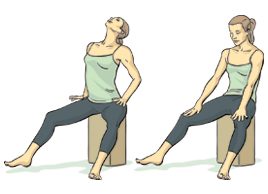Fitness trend: Gyrotonic
These exercises developed by a dancer can help improve muscle strength and posture

Growing up, I was always the tall girl. By age 11, I’d reached my current height of five foot nine, and towered over all but one boy in my class. I didn’t realize I was compensating for my height until a Grade 7 volleyball team photo made it clear that I slouched to appear shorter. I’ve been conscious of my poor posture ever since. Throughout the years, I have tried to improve it. In my career as a freelance writer and co-founder of justthefactsbaby.com, I’ve tried an ergonomically correct workstation to force me to sit up, and yoga classes and strength training to tighten my core, but nothing elongated my spine. Then I did a Gyrotonic class, and my posture was transformed.
How it works
Gyrotonic was created in the 1980s by former professional dancer Juliu Horvath of New York as a way of repairing his injuries. It looks like Pilates, but is done on elaborate wooden equipment. While Pilates focuses on static movements that strengthen the core, Gyrotonic stretches and strengthens muscles and tendons through a series of fluid spirals and rotations that look similar to dancing, but use a pulley system. The result is a toned physique that is more limber and better aligned’ ‘comparable to results from yoga, swimming or gymnastics. "Every exercise is built on circular movements," says Pascale Leonard, a Gyrotonic master trainer based in Montreal. Each movement requires you to fully extend your muscles, which elongates and increases spinal mobility. "The symmetrical movement also ensures each side of the body is worked in harmony," he says.
"Increased spinal mobility is also essential in helping heal injuries," says Crispin Redhead, owner of Gyrotonic Toronto by Crispin. "Your body should feel more aligned and agile after each session."
What it costs
Since Gyrotonic is performed on specialized equipment, it requires instruction. One-on-one classes are $50 to $100, and group classes are $25 to $50. A less expensive option is Gyrokinesis, ‘ similar movements but done on a chair or mat with no equipment. The results are comparable.
Finding the right instructor
Even with strict regulations for certification, some instructors will be better than others. Crispin Redhead encourages people to ask for feedback from other clients. Gyrotonic is about changing the way you stand and carry yourself, so look at an instructor’s clients to see if you like the way they move. Also, do a trial session before committing to a package. In Leonard’s opinion, "you should be hooked after one session." If you’re not, you might want to try another instructor.
To view videos of the exercises, log on to gyrotonic.com. The site can also help you find a location in your area. For now, in Canada they are in a few cities including Vancouver, Calgary, Winnipeg, Ottawa, Montreal, Halifax and the Toronto area.
The essential move: Arch and Curl
This is one of the foundation movements in Gyrotonic, and it doesn’t require any equipment. It sends energy through the upper body and mobilizes the spine. The Arch and Curl is a great way to start your day or get your body ready for any workout.
How to do it
Sit on the edge of a bench or chair with your legs in a V-position, feet flat on the floor. Place your hands behind your head or on your thighs. Arch your upper back, lifting your chest to the ceiling as you lean forward. Then contract your abdominals to round your spine, bringing your head downward as you return to a neutral spine. Repeat four to eight times.
This article was originally titled "Slouchy? Read This" in the January/February 2011 issue of Best Health. Subscribe today to get the full Best Health experience ‘and never miss an issue!’and make sure to check out what’s new in the latest issue of Best Health




